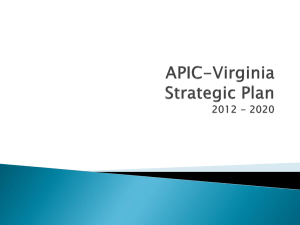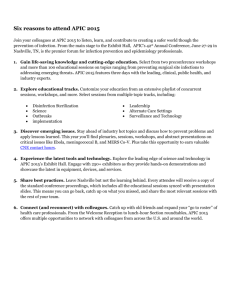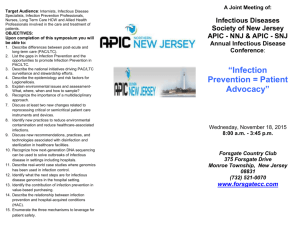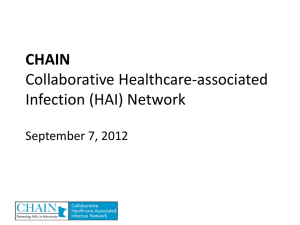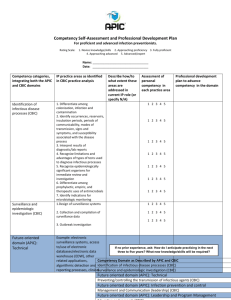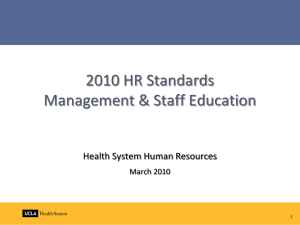Data Standardization Goal
advertisement
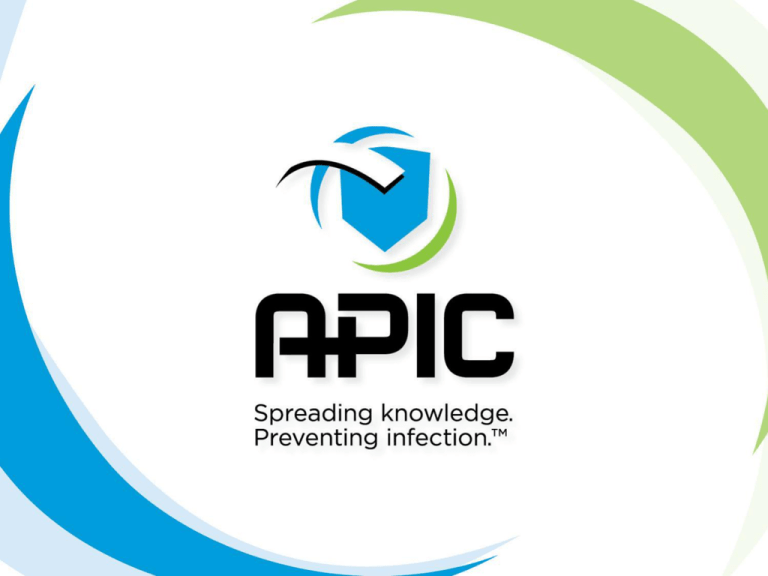
Association for Professionals in Infection Control and Epidemiology State of Association June 2013 Vision & Mission Vision: Healthcare without infection Mission: Create a safer world through prevention of infection www.apic.org/About-APIC/Vision-and-Mission Strategic Plan 2020 Goals: Patient Safety Goal Demonstrate and support effective infection prevention and control as a key component of patient safety. Implementation Science Goal Promote and facilitate the development and implementation of scientific research to prevent infection. IP Competencies & Certification Goal Define, develop, strengthen, and sustain competencies of the IP across the career span and support board certification in infection prevention and control (CIC®) to obtain widespread adoption. Advocacy Goal Influence and facilitate legislative, accreditation, and regulatory agenda for infection prevention with consumers, policy makers, health care leaders, and personnel across the care continuum. Data Standardization Goal Promote and advocate for standardized, quality and comparable HAI data. The Road Ahead • Leading Strategic Plan 2020 • Focusing on Quality and Value-added Member Services • Elevating the Profession • Developing the Role of Infection Preventionists • Building Organizational Leaders Infection Preventionists Who We Are IPs Nurses, medical technologists, public health, epidemiologists, microbiologists, physicians, and other healthcare professionals What We Do Surveillance Collect, analyze, and interpret health data in order to track infection trends, plan appropriate interventions, measure success, and report relevant data to public health agencies. Implement the Science and Enhance Clinical Practice Establish scientifically based infection prevention practices and collaborate with healthcare team to guide implementation Identify Sources of Infection Work to prevent HAIs in healthcare facilities by isolating sources of infections and limiting their transmission. Educate Educate healthcare personnel and the public about infectious diseases and how to limit their spread. Core Programs Education & Professional Development Public Affairs & Advocacy Foundational/ Infrastructure Services • • • • Membership IT Finance HR Practice Guidance & Research • • • • Governance Communications Marketing Strategic Partnerships 2013 Membership Stats Total members: 14,792 Retention rate: 75% International: 2% 124 Chapter Network (2 international) Membership has grown 40% over the past 5 years. Improving customer experience • Easier web features and resources • Using automated messages to ensure members receive timely reminders about benefits • Organizational focus on ways to improve customer experience • Reduction in number of complaints Strengthen component relations • Developing stronger local chapters by enhancing leader training and resources • Created new reports and web tools to help local leaders further engage members • Revamping Sections’ focus, activities, and leadership structure to add more value to members • Newly enhanced Section web pages Mentoring Program • Re-launching mentoring program to support efforts to build stronger IP and leadership competencies • Improved online functionality for easier sign up, easier search, and easier connection • Created additional tools to help mentors and mentees identify objectives and plan out actions for effective mentoring relationships Elevating awards and recognition • Introduced new awards in 2012/2013: – APIC/SHEA/HHS Partnership in Prevention Award – Distinguished Scientist Award – Implementation Science Abstract Award – Judene Bartley Advocacy in Action Scholarship • Hosted 1st annual Science to Practice event showcasing scientific excellence • Revising award criteria – Chapter Excellence Award – Carole DeMille Award Patient Safety Patient Safety Goal Demonstrate and support effective infection prevention and control as a key component of patient safety. 1.Messaging IPC as key component of patient safety versus bottom line cost savings 2.Competency model emphasizes patient safety as primary goal 3.Collaborative initiatives between IPs and other professionals 4.Reimagining IIPW as broad based, yearlong campaign with focus on educating and engaging consumers 5.Media coverage expanding and reinforcing messaging 6.Expanding communications and messaging to long-term care and critical access hospitals Annual Conference Registration: 4,103 Clinical Attendees: 2,464 Exhibitors: 1,515 CE Exhibitors: 98 Press: 26 Exhibit Hall Sq Footage Sold: 50,700 As of 6/09/13 Building Bridges Between IPs and Key Stakeholders IP & Lab/Microbiology— Tools for IPs & Lab professionals - Partnership with American Society for Microbiology (ASM) Clean Spaces, Healthy Patients— Tools for IPs & EVS - Partnership with Association for the HealthCare Environment (AHE) Consumer outreach Press Coverage Reinforces Key Messages Jennie Mayfield, clinical epidemiologist, BarnesJewish Hospital/Washington University School of Medicine, St. Louis, and president-elect, APIC, says science about C. diff's multiple strains and how the pathogen moves among populations remains a mystery. "I think until we answer some of those basic questions, hospitals are going to continue to do what seems to work in their individual facilities. It becomes a case of my hospital is doing one thing and the hospital next door may do something else to prevent the spread," she says. -- Health Facilities Management, May 2013 Study: Infection Preventionists Recognize Evidence for IP Practices -- Beckers, 2/4/13 “Hospitals are pushed to fight superbugs” -- Boston Globe, 4/30/13 “However, only 42 percent of respondents said C. difficile infection rates at their facilities had declined, while 43 percent said there was no decrease, according to the findings presented Monday at an APIC conference on C. difficile, held in Baltimore.” -- HealthDay, 3/14/13 APIC in the News Publications Implementation Science Implementation Science Goal: Promote and facilitate the development and implementation of scientific research to prevent infection. 1.Funding research to support APIC priorities (Heroes Scholars) 2.Increasing visibility and recognition (Science to Practice event, abstract & scientific awards, Heroes, new implementation science award) 3.Topic-focused symposia (C. difficile) 4.Collaborating with HRET/AHA (On the CUSP CAUTI) 5.Promoting graduate research studies in IPC 6.Defining IS and developing conceptual model 7.Increasing member engagement with AJIC 8.Elevating quality and expanding practice resources (Implementation Guides, manuals, APIC Text) Heroes Program 12 IP Heroes were selected and their contributions to increasing patient safety and implementation science are being showcased in a variety of ways. The criteria for selection of Heroes Major contributions in the areas of: – education –patient safety –advocacy and influence –process and systems improvement –program development, and –cost savings. Winners were selected based on sustainability of a program, quantitative proof of success of a program, & diversity of awardees Two $50,000 scholarly awards for research aligned with APIC strategic priorities were awarded and in progress Expanded Scope of Research Program Activities • Continued support for the Infection Prevention in the ED research project at Brigham and Women’s Hospital, funded by AHRQ. Results will be presented June 9, 1:30 – 4:00 pm, Workshop 2300. • In collaboration with the Practice Guidelines Committee, developing new training and resource materials to help IPs better understand and use research • Developing a new funding mechanism to support graduate student research on infection prevention • Supporting new national study on Pseudomonas Work in Progress •Development of a new conceptual model showing • How science moves into practice • The expected role of the IP in this process •A collaborative project by the PGC and RC •Will be published in AJIC Peer-reviewed Journal American Journal of Infection Control (AJIC) Issuing monthly press releases to promote research with focus on clinical practice and implementation science Highlighting relevant AJIC papers in Prevention Strategist Featured more prominently on APIC website Increased communications between APIC & editor Increased communications between APIC & publisher Expanded journal to monthly publication Practice Guidelines & Resources • APIC Text: Full revision by year’s end; release at annual conference 2014 • Implementation guides: C. difficile (released), Emergency Medical Services (released), CLABSI in progress, CAUTI, Hand Hygiene • Resources for Review, Comment, &/or Endorsement: – Healthcare Professionals Vaccination Toolkit – Revised LTC HAI Surveillance Criteria – CDC Single Dose Vial Position – WHO novel coronavirus (nCoV) and HCW H7N9 exposure reviews Practice Guidelines & Resources Competency & Certification IP Competencies & Certification Goal: Define, develop, strengthen, and sustain competencies of the IP across the career span and support board certification in infection prevention and control (CIC®) to obtain widespread adoption. 1.Publication and dissemination of IP Competency Model 2.Tools to promote application of the model and self-assessment of competency level developed and introduced 3.Competency Advancement Awards funded and initiated 4.Education incorporating competency level and domain identifiers 5.Collaborative efforts with CBIC promote value of certification (published papers, websites, CICs showcased in PS & Show Daily) 6.Number of CIC applications up 20% and recertification 30% 7.Recognition and celebration of CICs 8.Collaborative efforts with APIC chapters to collect data IP Competency Model • The model has been developed to illustrate current and future practice along the infection preventionist’s (IP) career path. • The core of the model is based on the principles and practices of safety science. Foundational elements also include the CBIC® core competencies and professional practice standards. • Baseline IP core competencies are defined by CBIC ® and are derived from their evidence-based practice analysis research. • The four green “spokes” of the diagram indicate priority areas of professional development for all IPs in the near future (3-5 years) These areas expand on the foundational components. While individual skills will vary, the intent is that ongoing professional development will lead to mastery across domains over time. • CIC® certification represents the bridging point between novice and proficient career levels and is the hallmark of competency across the career continuum. • The advanced (expert) will have achieved a high level of knowledge and skill in those domains most closely aligned with the IP’s career goals. The Competency Model: Next Phase New Self Assessment Tool focuses on proficient and advanced career stages Integration of CBIC ® core competencies with the four future oriented domains described in the competency model An expanded version of the tool can be downloaded from the APIC web site Competency Advancement Awards are entering their second year • Sponsored by APIC Strategic Partner Program • Award includes: – One year subscription to the APIC Text Online, copy of the Competency Review book, and access to the APIC ANYWHERE ® certification review course – Reimbursement of exam fee upon successfully passing CIC exam Results, Year One (2012 – 2013) 81 awards granted 34 new CICs by April 20, 2013 77% pass rate Advocacy Advocacy Goal: Influence and facilitate legislative, accreditation, and regulatory agenda for infection prevention with consumers, policy makers, health care leaders, and personnel across the care continuum. 1.Advocating for infection prevention with federal regulatory agencies 2.Beginning to educate Congress on APIC and IPs 3.Promoting advocacy by APIC chapters to educate state legislatures 4.Collaborating/partnering with accreditation organizations to promote risk assessment and certification 5.Developing campaign for consumer engagement Patient Safety and Data Standardization Advocacy ESRD PPS OPPS/ASC PPS EHR Incentive Program – Stage 2 Hospital IPPS/LTCH PPS Physician Fee Schedule Inpatient Rehab. Facility PPS Expected: Infectious Disease Standard Draft legislation: regulation of compounding pharmacies Testimony: Federal HAI programs Unique Device Identifiers Antiseptic Pre-op Skin Prep. Products Antibiotic use in foodproducing animals Veterinary Feed Directive Support data standardization and HAI research HIT Meaningful Use Stage 3 National Action Plan to Prevent HAIs Phase 3 LTC Report on unsafe injection practices in ASCs Data Standardization Data Standardization Goal: Promote and advocate for standardized, quality and comparable HAI data. 1.Advocating gold standard for surveillance data and pay for performance related to HAIs be NHSN 2.Advocacy campaign to increase budget for NHSN infrastructure 3.Collaborating with other professional associations, key stakeholders, vendors, and CDC to develop compatible technology (EHR, e-surveillance) Federal HAI Reporting To NHSN 2011 • CLABSI – Acute Care ICUs (Jan.) 2012 • • • • • CAUTI – Acute Care ICUs (except NICUs) (Jan.) CAUTI – LTCH, IRF, Cancer Hospitals (Oct) SSI – Colon Surgeries and Abdominal Hyst. – Acute Care (Jan) Dialysis Events – ESRD (Jan) CLABSI – LTCH, Cancer Hospitals (Oct) 2013 • • • • C. Diff LabID Events – Acute Care (Jan.) MRSA Bacteremia LabID Events – Acute Care (Jan.) HCP Influenza Vaccination – Acute Care (Jan.) HCP Influenza Vaccination – LTCH (Jan.) 2014 • HCP Influenza Vaccination – ASCs (Oct.) • • • • • • CLABSI – Acute Care, Med, Surg, Med/Surg Units (Jan.) CAUTI – Acute Care, Med, Surg, Med/Surg Units (Jan.) MRSA Bacteremia LabID Events – LTCH (Jan.) C. Diff LabID Events – LTCH (Jan.) SSI – Cancer Hospitals (Jan.) HCP Influenza Vaccination – IRF (Oct.) 2014 Proposed Why Talk To Policymakers About NHSN? Federal Agencies use varied HAI data collection systems. Patients and IPs benefit from the use of NHSN which: •provides a clearly defined, scientifically sound system for reporting HAIs •ensures fair comparisons between facilities. Talking to legislators about NHSN allows us to discuss: •who infection preventionists are and the important work they do to protect patients; •how the use of actionable data helps focus HAI prevention efforts; •the need for research to address scientific gaps in HAI prevention. We are not calling for more data collection, just adequate funding to support the functionality of NHSN. •In this budget climate, that won’t happen without advocacy. Building a Coalition Around Common Goals HAI Focus Patient Advocacy of Connecticut Health Watch USA Challenges Challenges over next couple of years: 1.Serving a diverse membership (alternate practice settings, international) 2.Increasing member participation and engagement 3.Reducing dependency on corporate support 4.Increasing the perceived value of IPs in their practice setting 5.Increasing resources for IPC programs 6.Increasing resources to close certification and competency gaps

